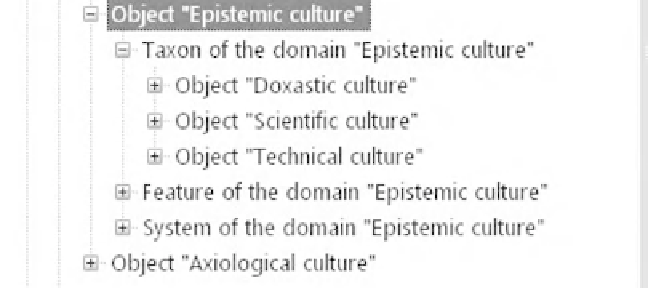Information Technology Reference
In-Depth Information
Finally, a
third group
of conceptual terms serves us to discuss the thematization
of knowledge objects relating not to artistic or literary works, but rather to the
reference frameworks, to artistic, literary or musical cultures.
Let us now take a brief look at some examples from the
first
and
thirdgroups
; as
the second group is currently present only in a rudimentary form, we prefer to
discuss it later.
As Figure 13.17 shows, the first group of conceptual terms belonging to the
major branch [Secondly symbolic object] brings together the taxonomic domains
which are based on the terms [Object “Epistemic culture”], [Object
“Axiological culture”] and [Object “Culture of transcendence”]:
Figure13.18.
Thetaxonomicdomainwhoserootistheconceptual
term[Object“Epistemicculture”]
- the vocabulary which depends on the root conceptual term [Object “Epistemic
culture”] facilitates the description of systems of knowledge comprising
scientific
(or otherwise),
doxastic
(i.e. defining the evidence and truths for a social actor) or
indeed
technical
knowledge;
- the vocabulary which depends on the root conceptual term
[Object “Axiological culture”], as the expression “axiology” suggests, serves for
describing the values (be they collective or personal, general or specific to a
practice, a social field, etc.) including, notably, the norms, rules (explicit or tacitly
accepted) and other laws (juridical in the sense of contemporary law, pre-juridical,
traditional, customary, sacred, etc.). A category of conceptual terms which is set
somewhat apart (according to von Wright [VON 63]) but included in this vocabulary
of conceptual terms is that which facilitates the description of so-called technical
rules, i.e. instructions and procedures. Figure 13.18 shows the group which is

